Bayer R.G. Mechanical Wear Fundamentals and Testing, Revised and Expanded
Подождите немного. Документ загружается.

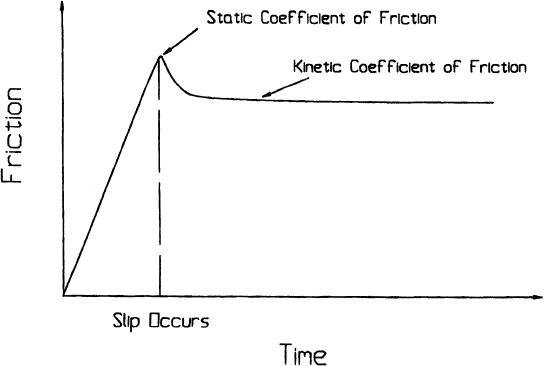
Frequently, the friction associated with the initiation of sliding and the friction
associated with maintaining uniform motion are different. In terms of the coefficient
of friction, the value associated with the initiation is referred to as the static coefficient
of friction; the value for maintaining motion is the kinetic coefficient of friction. Gen-
erally, the static coefficient tends to be higher than the kinetic coefficient as a result of
increased juncti on growth that can occur under static conditions. This is the same con-
cept as that associated with the velocity dependency. An example of this type of fric-
tion behavior is shown in Fig. 5.16. While this behavior is common, the difference
between static and kinetic coefficients can often be negligible and exceptions to this
behavior are often encountered.
Before concluding the consideration of friction, the relationship between friction and
wear must be discussed. From the previous discussions on the origi ns of friction, frictional
behavior, and the prior treatment of wear, it can be seen that both frictio n and wear are
sensitive to the same parameters and the same general type of phenomena. This frequently
is an aid when addressing wear problems. Because of this common dependency, changes
to tribosurfaces that result in wear transitions frequently result in frictional changes as
well. This is illustrated in Fig. 5.17. As a result, the monitoring of friction behavior during
wear tests can aid in the identification of wear transitions. While this is the case, the same
trends sho uld not be assumed for both these phenomena. Material systems with higher
friction do not necessa rily have higher wear. Examples of this can be seen in Table 5.1
and Fig. 5.18. Another example is provided in the case of irradiated PTFE. In this case,
increased radiation doses tend to result in increased friction but lower wear rates (20).
One way of understanding this distinction between friction and wear trends is by
considering the energy dissipated by the system. Friction can be related to the total energy
dissipated. This energy can be considered to consist of two parts, heat energy and wear
energy. While the portion of the total energy going into heat generally predominates,
the ratio between these two forms can vary between tribosystems and for different wear
mechanisms. Consequently the same trends cannot be assumed for both phenomena.
Nonetheless, friction and wear are not independent. Wear can lead to surface mod-
ifications, which influence friction, such as film formati on and roughness changes.
Figure 5.16 Static and kinetic coefficients of friction.
Copyright 2004 by Marcel Dekker, Inc. All Rights Reserved.
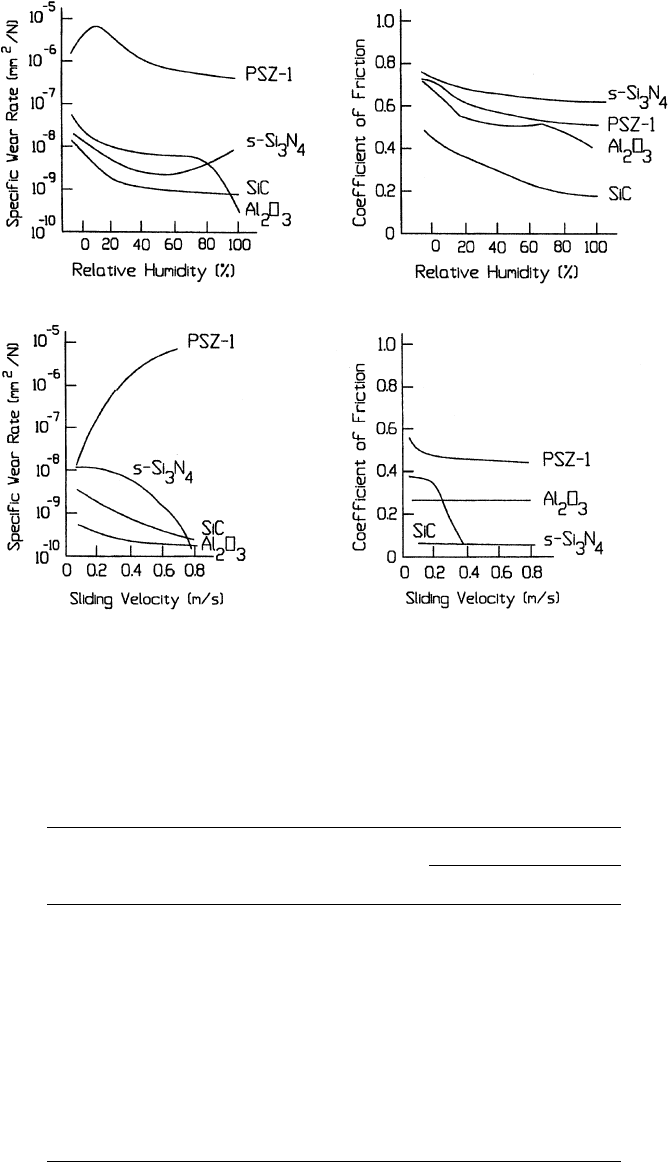
Figure 5.17 Changes in the coefficient of friction and wear rate of several self-mated ceramic
couples as a function of humidity and speed. (From Ref. 33.)
Table 5.1 Unlubricated Sliding Friction Coefficients and Wear
Wear (m
in
)
Tribosystem m Sphere Flat
52100 Sphere
302 SS flat 1.02 0 8
303 SS flat 0.79 0 5
410 SS flat 0.64 0 20
1018 Steel 0.80 0 4
4150 Steel 0.67 0 2
112 Aluminum 1.08 0 82
220 Aluminum 0.79 0 35
Brass sphere
410 SS flat 0.62 200 0
440 SS flat 0.72 72 0
Copyright 2004 by Marcel Dekker, Inc. All Rights Reserved.
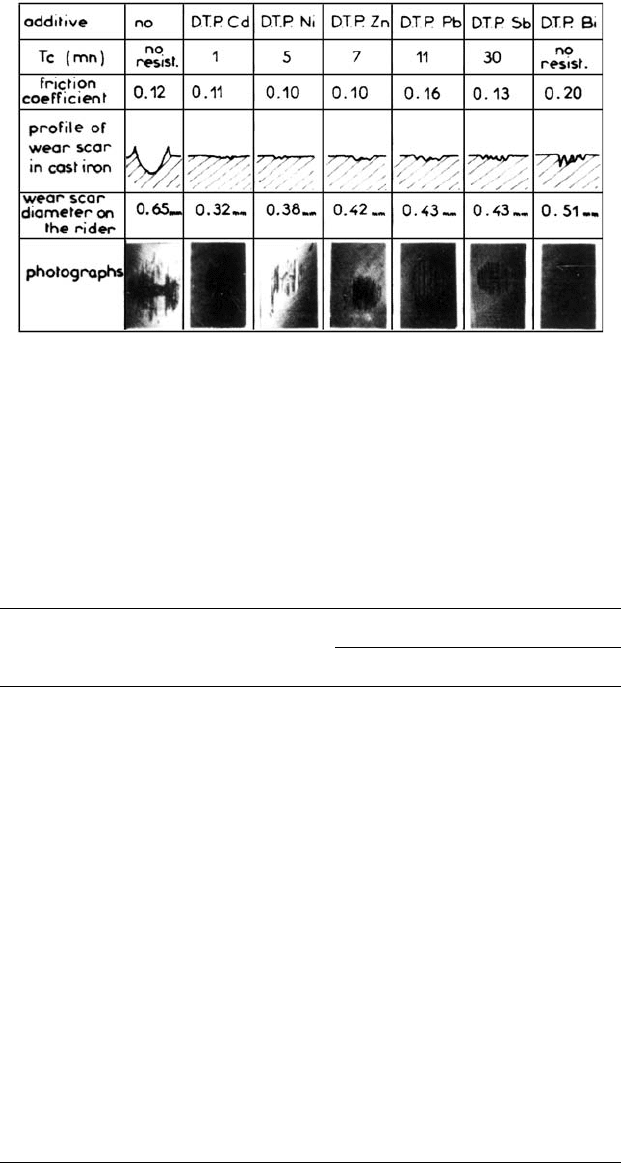
Friction, through a heating effect, can influence oxide formation and affect material prop-
erties, which in turn can influence wear behavior. In addition, friction modifies the contact
stress system by introducing a shear or traction component, which can also be a factor in
wear behavior (3,4,18,20–24). Because of these aspects, friction and wear must be generally
Figure 5.18 The influence of different lubricant additives on the coefficient of friction and wear
of a sliding 52100 steel=cast iron couple lubricated by paraffin oil. (From Ref. 21, reprinted with
permission form ASME.)
Table 5.2 Coefficients of Friction
m
Tribosystem Unlubricated Lubricated
Sliding
Steel=steel 0.6–0.8 0.1–0.3
Steel=stainless steel 0.7–1.2 0.1–0.3
Steel=Ni alloys 0.7–1.3 0.1–0.3
Steel=Cu alloys 0.7–1.2 0.15–0.3
Steel=Al alloys 0.8–1.4 0.1–0.3
Stainless steel=stainless steel 0.9–1.5 0.1–0.2
Acetal=steel 0.35 0.15
PTFE filled acetal 0.2–0.3
Nylon=steel 0.4–0.6 0.15–0.25
Graphite filled nylon=steel 0.6 0.25
MoS
2
filled nylon=steel 0.6 0.25
PTFE filled nylon =steel 0.1–0.2
PTFE=steel, low speed 0.05–0.08 0.05–0.08
PTFE=steel, high speed 0.3 0.3
Filled PTFE steel 0.09–0.12
Polyurethane=nylon 1–1.5
Isoprene=steel 3–10 2–4
Polyurethane=nylon 0.5–1
Rolling
Steel=steel 0.001 0.001
Copyright 2004 by Marcel Dekker, Inc. All Rights Reserved.
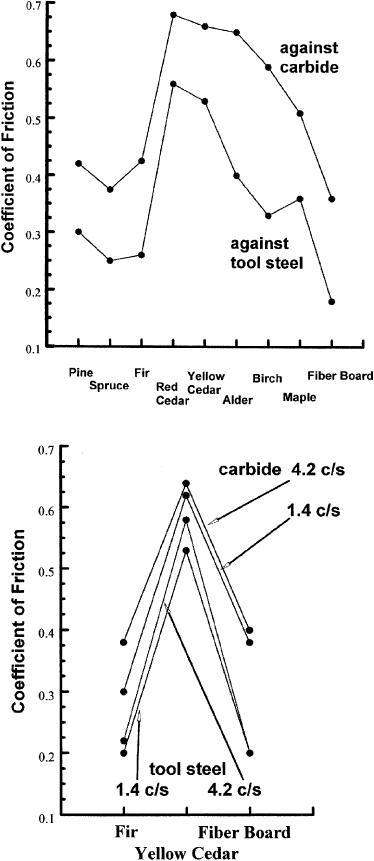
considered as related phenomena, but not equivalent phenomena. However, direct cor-
relation between the two is possible in specific cases or for specific systems.
In Tables 5.2 and 5.3, typical values of the coefficient of friction for a variety of sys-
tems are given as a general reference. Table 5.2 is for common engineer ing materials, while
Table 5.3 is for medical and dental materials. Figure 5.19 contains coefficients of friction
for different woods. It is interesting to note that while normalized wear coefficients range
over many orders of magnitude, friction values cover a much more limited range.
Figure 5.19 Coefficient of friction of various woods sliding against carbide and steel counterfaces.
(From Ref. 34.)
Copyright 2004 by Marcel Dekker, Inc. All Rights Reserved.
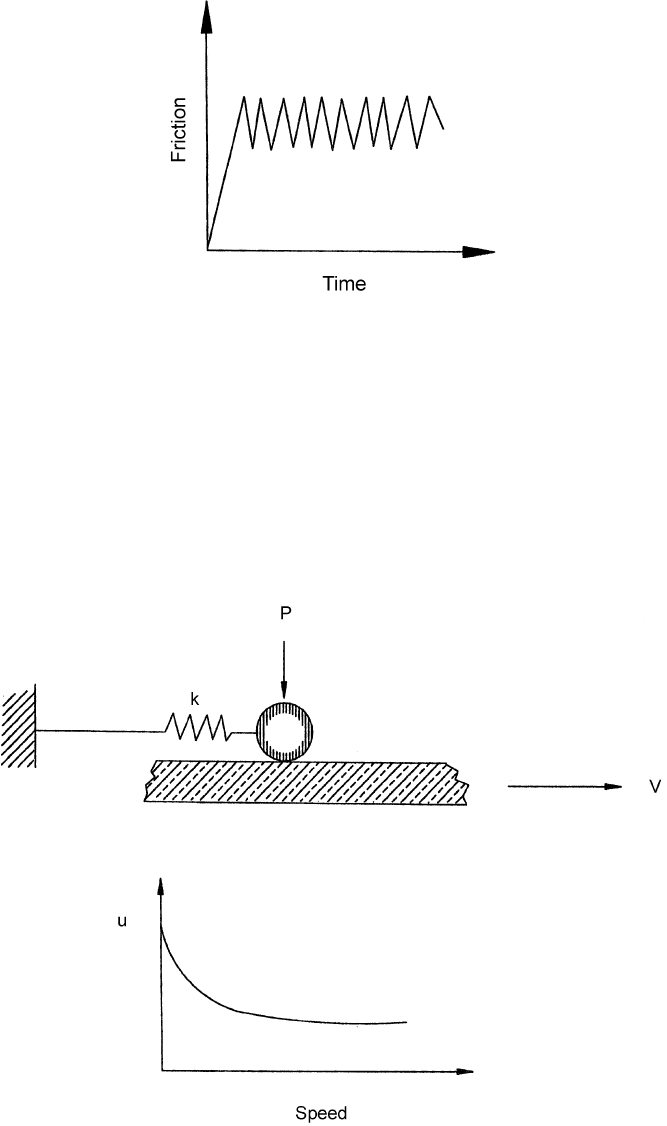
There is one additional aspect of fri ction that needs to be considered. This is stick-
slip. This is manifested in fricti on traces of the type illustrated in Fig. 5.20 and frequently
as noise in a slid ing system. The peaks in these traces associated with stick-slip give the
static coefficient of friction. The lower value is dependent on the dynamic characteristics
of the system, material properties, and the measurement system used to record the data,
and therefore does not provide a measurement of the friction. Two conditions are required
for the occurrence of this phenomenon. One is a variable coefficient of friction, the other is
Figure 5.20 Stick-slip behavior.
Figure 5.21 A model for stick-slip behavior.
Copyright 2004 by Marcel Dekker, Inc. All Rights Reserved.

Table 5.3 Coefficient of Friction for Medical, Dental, and Biological Materials
Material couples
Coefficient of friction
Dry Wet
Amalgam on:
Amalgam 0.19–0.35
Bovine enamel 0.12–0.28
Composite resin 0.10–0.18
Gold alloy 0.10–0.15
Porcelain 0.06–0.12 0.07–0.15
Bone on:
Metal (bead-coated) 0.50
Metal (fiber mesh-coated) 0.60
Metal (smooth) 0.42
Bovine enamel on:
Acrylic resin 0.19–0.65
Amalgam 0.18–0.22
Bovine dentin 0.35–0.40 0.45–0.55
Bovine enamel 0.22–0.60 0.50–0.60
Chromium–nickel alloy 0.10–0.12
Gold 0.12–0.20
Porelain 0.10–0.12 0.50–0.90
Composite resin on:
Amalgam 0.13–0.25 0.22–0.34
Bovine enamel 0.30–0.75
Gold alloy on:
Acrylic 0.6–0.8
Amalgam 0.15–0.25
Gold alloy 0.2–0.6
Porcelain 0.22–0.25 0.16–0.17
Hydrogel-coated latex on:
Hydrogel 0.054
Laytex on:
Glass 0.47
Hydrogel 0.095
Metal (bead-coated) on:
Bone 0.54
Metal (fibre mesh-coated)
Bone 0.58
Metal (smooth) on:
Bone 0.43
Prosthetic tooth material
Acrylic on acrylic 0.21 0.37
Acrylic on porcelain 0.23 0.30
Porcelain on acrylic 0.34 0.32
Porcelain on porcelain 0.14 0.51
Source: Ref. 25
Copyright 2004 by Marcel Dekker, Inc. All Rights Reserved.
elasticity in the sliding system. The basic concept is that elasticity in the system allows
variations in friction to produce oscillations between the two members. If the system
were rigid, no oscillations would start, or if the friction were constant, there would be
no variable force to initiate the oscillation. This can be illustrated by considering a sim-
ple example in whi ch the static coefficient of friction is higher than the dynamic coeffi-
cient. Consider the situation shown in Fig. 5.21. As the flat begins to move, the ball
follows until the stored elastic energy in the spring overcomes the friction. At this point,
the ball becomes free and moves relative to the flat. This results in reduced friction. At
some point of time, determined by the stored energy in the spring and the energy dissi-
pated by friction, the ball will stop moving relative to the flat. At this point, the cycle
will repeat itself. There can be many reasons for the instability of the coefficient of fric-
tion. However, stick-slip is frequent ly observed under conditions, which favor adhesion,
such as clean, dry surfa ces, marginal lubrication, etc.
REFERENCES
1. E Rabinowicz. Friction and Wear of Materials. New York: John Wiley and Sons, 1965.
2. F Bowden, D Tabor. The Friction and Lubrictation of Solids. New York: Oxford U. Press.
Part I, 1964, and Part II, 1964.
3. M Moore. Energy dissipated in abrasive wear. Proc Intl Conf Wear Materials ASME 636–638,
1979.
4. N Suh, P Sridbaran. Relationship between the coefficient of friction and the wear rate of
metals. Wear 34(3):291–300, 1975.
5. D Moore. Proceedings of the Third Leeds–Lyon Symposium on Trib. Guildford, UK: Butter-
worth Scientific, Ltd., 1976, p 114.
6. R Bayer, J Sirico. The friction characteristics of paper. Wear 17:269–277, 1971.
7. E Rabinowicz. Friction. Friction and Wear of Materials. New York: John Wiley and Sons,
1965, pp 62–64.
8. J Migoard. Proc Phys Soc 79:516, 1962.
9. F Bowden, D Tabor. Polymeric materials. The Friction and Lubrication of Solids. Part II. New
York: Oxford University Press, 1964, pp 223–225.
10. F Bowden, D Tabor. The friction of elastic solids. The Friction and Lubrication of Solids. Part
II. New York: Oxford University Press, 1964, p 252
11. F Bowden, D Tabor. The friction of elastic solids. The Friction and Lubrication of Solids. Part
II. New York: Oxford University Press, 1964, pp 242–254.
12. R Bayer. A general model for sliding wear in electrical contacts. Wear 162–164:913–918, 1993.
13. P Engel, E Hsue, R Bayer. Hardness, friction and wear of multiplated electrical contacts. Wear
162–164:538–551, 1993.
14. F Bowden, D Tabor. The friction of elastic solids. The Friction and Lubrication of Solids. Part
II. New York: Oxford University Press, 1964, pp 252.
15. E Rabinowicz. Friction. Friction and Wear of Materials. New York: John Wiley and Sons,
1965, pp 58–59.
16. D Buckley, K Miyoshi. Friction and wear of ceramics. Wear 100:333–339, 1984.
17. M Moore, P Swanson. The effect of particle shape on abrasive wear: A comparison of theory
and experiment. Proc Intl Conf Wear Materials ASME 1–11, 1983.
18. G Briggs, B Briscoe. Wear 57:269, 1979.
19. E Rabinowicz. Adhesive wear. Friction and Wear of Materials. New York: John Wiley and
Sons, 1965, pp 133–134.
20. B Briscoe, Z Ni. The friction and wear of g-irradiated polytetrafluoroethylene. Wear 100:
221–242, 1984.
Copyright 2004 by Marcel Dekker, Inc. All Rights Reserved.
21. J Martin, J Georges, G Meille. Boundary lubrication with dithiophospates: Influence of lubri-
cation of wear of the friction interface steel=cast iron. Proc Intl Conf Wear Materials ASME
289–297, 1977.
22. K Muller. Prediction of the occurrence of wear by friction force-displacement curves. Wear
34:439–448, 1975.
23. L Mitchell, C Osgood. Prediction of the reliability of mechanisms from friction measurements.
Proceedings of the First European Trib. Congress, Inst. of Mech. Eng., 1973, pp 63–70.
24. H Shimura, Y Tsuyad. Effects of atmosphere on the wear rate of some ceramics and cermets.
Proc Intl Conf Wear Materials ASME 452–461, 1977.
25. http:==www.lib.umich.edu=libhome=Dentistry.lib=Dental_t ables=Coeffric.html, Dentis-
try Library, U. of M ichigan.
26. F Bowden, D Tabor. The friction of elastic solids. The Friction and Lubrication of Solids. Part
II. New York: Chapter XIV Oxford University Press, 1964, pp 242–276.
27. Bayer R, Sirico J. Comments on the frictional behavior between a print character and a carbon
ribbon. Wear 11:78–83, 1968.
28. J Whitehead. Proc Roy Soc A 201:109, 1950.
29. E Rabinowicz. Friction. Friction and Wear of Materials. New York: John Wiley and Sons,
1965, p 62.
30. M Barquins. Adherence, friction and wear of rubber-like materials. In: R Denton, M Kesha-
van, eds. Wear and Friction of Elastomers. STP 1145, ASTM, 1992, pp 82–113.
31. S Lim, M Ashby. Wear-mechanism maps. Acta Metal 35(1):1–24, 1987.
32. E Rabinowicz. Friction. Friction and Wear of Materials. New York: John Wiley and Sons,
1965, p 60.
33. S Sasaki. The effects of surrounding atmosphere on the friction and wear of alumina, zirconia,
silicon carbide, and silicon nitride. Proc Intl Conf Wear Materials ASME 409–418, 1989.
34. P Ko, H Hawthorne, J Andiappan. Tribology in secondary wood machining. In: S Bahadur
and J Magee, eds. Wear Process in Manufacturing. STP 1362, ASTM, 1999.
Copyright 2004 by Marcel Dekker, Inc. All Rights Reserved.
6
Lubrication
A lubricant is any substance, fluid or solid, which when placed between two surfaces
reduces either the friction between the two surfaces or the wear of either surface. Consis-
tent with the fact that wear and friction are distinct phenomena, a lubricant does not
necessarily have to do both or be effective to the same degree for each of these phenomena.
This aspect is demonstrated by the following examples.
The effect of different oils on the coefficient of friction and the wear behavior for
several combination of sliding metal pairs is presented in Table 6.1. It can be seen that
minimum friction and minimum wear are not necessarily obtained with the same lubri-
cant. It can also be seen that all the lubricants do reduce both friction and wear but that
the degree of improvement can be significantl y different. Since the coefficient of friction
for these systems ranges from approximately 0.5 to 1.0 without the use of a lubricant,
the coefficient of friction is reduced by a factor of 1=2to1=4 with the use of these lubri-
cants. The reduction in wear is generally far more pronounced, typically being an order of
magnitude or more.
While it is generally found that both wear and friction are simultaneously reduced by
the use of a lubricant, as illustrated by the data shown in Table 6.1, it is not always the
case. It is possible that a lubri cant may decrease friction while increasing wear. An exam-
ple of this is one in which the wear of primary system is controlled by transfer or tribofilm
formation film formation. As was discussed in the section on wear phenomena, the addi-
tion of a lubricant in such a system can increase the wear by inhibiting the formation of the
film. However, the lubricant can still be effective in reducing the adhesive component of
friction for the basic pair of materials. Data illustrating this are shown in Table 6.2.
For most of these systems, transfer films were observed to form for unlubricated sliding
conditions but not under lubricated conditions. In these cases, the data show that the wear
increased with the use of the inks while the coefficient of friction generally reduced. For a
material pair which did not form a transfer film under the same unlubricated sliding
conditions, lubrication by these inks reduced both friction and wear.
Systems, which have low coefficient of friction under unlubricated conditions (< 0.1),
can sometimes exhibi t the opposite behavior, that is the wear is reduced but the friction
increases. In these cases, the viscous losses in the lubricant can significantly contribute
to the overall friction. The significance of such a contribution to the coefficient of friction
can be illustrated by the case of 302 stainless steel sliding on polytetrafluoroethylene
(PTFE). In tests with a ball–plane friction and wear apparatus, the coefficient of friction
was measured to be 0.09 without lubrication. With a low viscosity paraffin oil, the coeffi-
cient increased to 0.12 and with a higher viscosity paraffin oil, to 0.15 (1). Part of this
increase can also be related to the effect that the use of a lubricant has on the formation
of transfer films.
Copyright 2004 by Marcel Dekker, Inc. All Rights Reserved.

Another example of a tribosystem in which lubrication can reduce wear but increase
friction is rolling bearings. Rolling contacts fall into this category of low, unlubri cated
friction. Coefficients of friction for rolling are typically less than 0.1 (2). With ball and
roller bearings, lower friction is usually obtained without the use of oil or grease; however,
life and loading capacity are generally increased by the use of a lubricant (3–5). The
Table 6.2 The Effect of Lubrication on Wear and Friction for Several Plastics Against a 302
Stainless Steel Slider
Plastic Wear depth (cm) m Evidence of film formation
PPS
Dry 4 10
3
0.5 No
Lubricated 1.5 10
4
0.16 No
PPS þMoS
2
þSb
2
O
3
Dry 8 10
4
0.5 Yes
Lubricated 1.5 10
3
0.35 No
PPS þGlass þPTFE
Dry 1 10
4
0.15 Yes
Lubricated 1.5 10
4
0.16 No
Acetal þPTFE
Dry 1 10
4
0.14 Yes
Lubricated 1.5 10
4
0.12 No
Polyester þGraphite þPTEF
Dry 4 10
5
0.18 Yes
Lubricated 8 10
5
0.16 No
Lubricant was a non-abrasive aqueous-based electrostatic ink.
Source: Ref. 10.
Table 6.1 Effect of Three Different Hydrocarbon Lubricants on the Wear and Friction of
Different Metal Couples
a
Couple
Lubricant
Minimum
reduction in
system wear with
lubrication
m
without
lubrication
ABC
h
(m in) m
h
(m in) m
h
(m in) m
52100=415 12 0.15 0 0.13 5 0.17 5 10
4
0.97
52100=440 6 0.12 8 0.13 5 0.18 5 10
4
0.66
52100=1060 77 0.20 26 0.20 38 0.32 0.02 0.73
52100=phosphor bronze 11 0.23 0 0.16 0 0.18 3 10
3
0.74
302=1060 0 0.15 10 0.15 21 0.16 1 10
3
0.88
302=220 aluminum 10 0.18 0 0.17 16 0.25 2.5 10
3
0.92
Brass=1055 110 0.20 32 0.19 110 0.25 0.01 0.69
Brass=220 Aluminum 90 0.14 108 0.15 90 0.19 0.5
b
0.95
Brass=Monel C 21 0.22 21 0.21 108 0.28 5 10
3
0.85
a
Data from reciprocating ball–plane tests, using different test loads for the different material couples. h is the
depth of the wear scar on the wearing member, which is italicized.
b
With lubrication the brass wears; without lubrication the aluminum wears.
Copyright 2004 by Marcel Dekker, Inc. All Rights Reserved.
